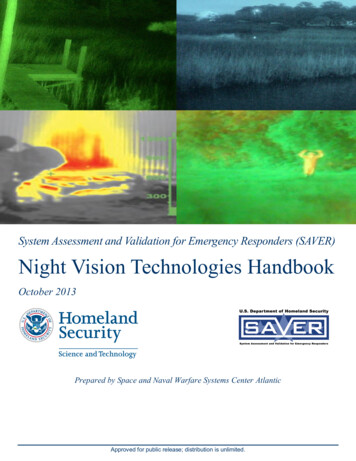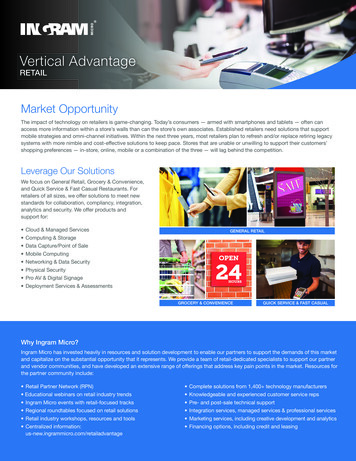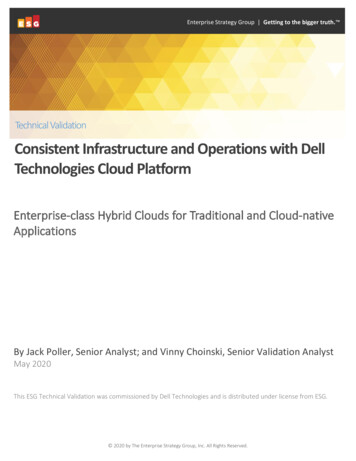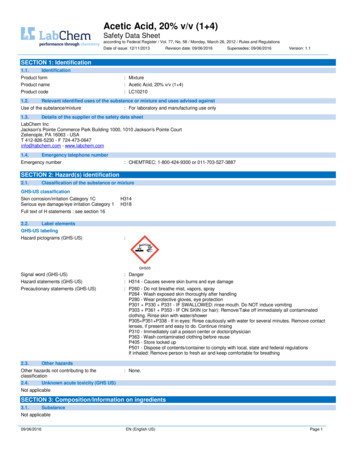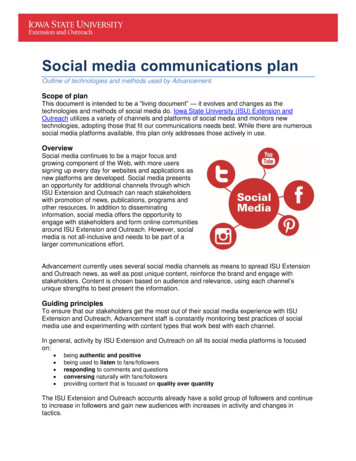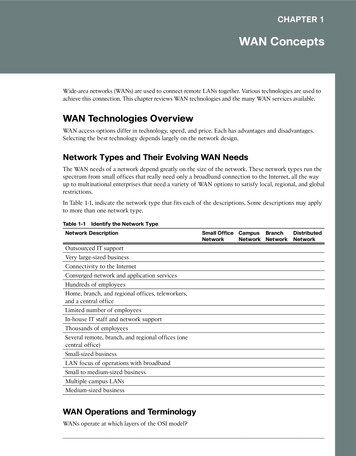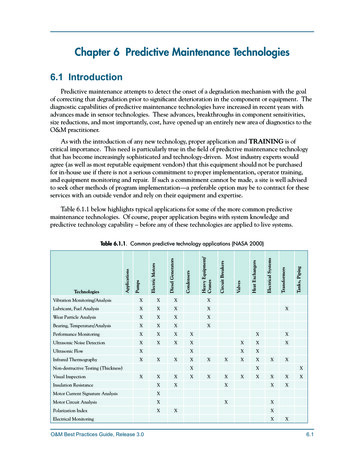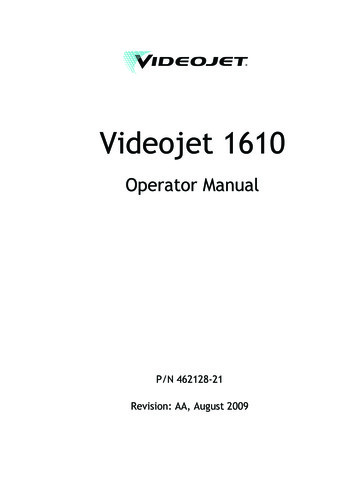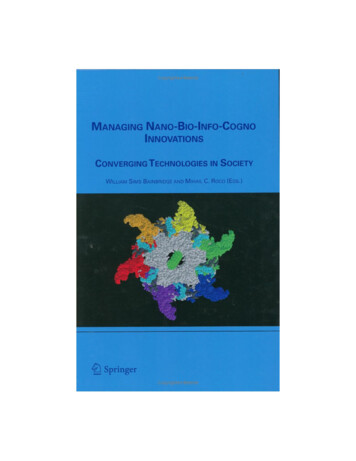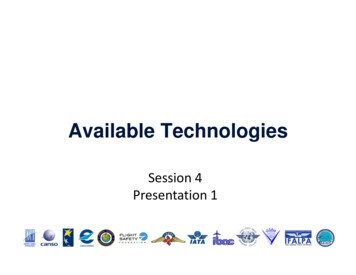
Transcription
Available TechnologiesSession 4Presentation 1
International Coordinating Council of Aerospace Industries AssociationsRunway Incursions, Confusion andExcursions are a leading cause ofAviation AccidentsICAO Regional Runway Safety Seminar
International Coordinating Council of Aerospace Industries AssociationsRunway Incursion & ConfusionICAO Regional Runway Safety Seminar
International Coordinating Council of Aerospace Industries AssociationsRunway Incursion & ConfusionEliminating Runway Incursion and Confusion requires FlightCrew Awareness of:– Position of Own Ship on the Airport Surface– Position of Other Traffic on the Airport Surface– Taxi Route– Conflicting TrafficICAO Regional Runway Safety Seminar
International Coordinating Council of Aerospace Industries AssociationsAvailable EquipageSituationalAwarenessAirport Moving MapOn NDAirport Moving MapOn Class 2/3 EFBSmart RunwayAlertingPosition Awareness(incursion/confusion)Runway Proximity AlertsOn ND/PFDRunway Disagree AlertsOn ND/PFDICAO Regional Runway Safety Seminar5
International Coordinating Council of Aerospace Industries AssociationsAvailable EquipagePositional Awareness via Airport Moving Map (Airbus OANS in-service example)Runway ProximityICAO Regional Runway Safety Seminar6
International Coordinating Council of Aerospace Industries AssociationsAvailable EquipagePositional Awareness via TAWS (Honeywell Smart Runway in-service example)“On Runway Zero-Nine Left”09L7“Approaching Zero-Nine Left”ICAO Regional Runway Safety Seminar7
International Coordinating Council of Aerospace Industries AssociationsAvailable EquipagePositional Awareness via FMS (Boeing Runway Disagree Alerting in-service example)09LICAO Regional Runway Safety Seminar8
International Coordinating Council of Aerospace Industries AssociationsFuture Equipage StudiesSurface CDTISituationalAwarenessTaxi Route DisplayOn Airport Moving MapRunway StatusIndications On AirportMoving MapAlertingPosition, Taxi Route,& Traffic Awareness,Traffic AlertingSurface Traffic ConflictAlertsRunway Incursion AlertsICAO Regional Runway Safety Seminar9
International Coordinating Council of Aerospace Industries AssociationsFuture Equipage StudiesAirport Moving Map with Taxi Route, Traffic, Runway Status Indications andTraffic Conflict Alerting (Boeing concept example)ICAO Regional Runway Safety Seminar10
International Coordinating Council of Aerospace Industries AssociationsRunway ExcursionsICAO Regional Runway Safety Seminar
International Coordinating Council of Aerospace Industries AssociationsOverrun leApproachFriction limited /Runway contamination(Too High, Too s often arecaused byoftenmore arethanOverrunsone factor!caused by more thanone factor!Source: FDR data sent to Boeing Aero Safety, 2003-present,Models: Boeing Puget SoundDecisionDecisionHeightICAO Regional Runway Safety SeminarHeightSpeedbrakeslate / notdeployedReversers late /Not deployedReverser level too low /Reduced too soon
International Coordinating Council of Aerospace Industries AssociationsOverrun Risk MitigationsSuggested Operationand Procedural ayconditions reportingNo approvedTouchdown zone c igh, Too Fast)landingdistance approachStabilized“De-stigmatize” Go- AroundReal time dynamicperformance predictionTailwindHighcaused bymoreOverrunsoftenarethanAuralvisual Go-Around decisiononeandfactor!causedbymore thanaidsone factor!HeightReversers late /Not deployedReal time dynamic stoppingdistance estimationAural and visualGo-Aroundtouchdowndecision aids speedAural and visual decelerationReverserlevelaidstoo low /devicesusageHead-Down and Head-Upvisual cuesHead-Down and Head-Up visualcuesDecisionHead-Down and Head-Up visual cuesDecisionHeightSource: FDR data sent to Boeing Aero Safety, 2003-present,Flare guidanceICAO RegionalRunway Safety SeminarModels: Boeing Puget SoundMaintain thrust reverserFriction limited /deploymentRunway contaminationSpeedbrakeslate / notdeployedSuggested equipage enhancements:Real time dynamic performancepredictionOverruns often areABtooUse all decelerationdeviceslowLong-LandingStability alertingConfigurationReduced too soonDeceleration alerting
International Coordinating Council of Aerospace Industries e OnBoard TechnologyAirportInfrastructuresHoneywellFSF/IATA Approachand Landing AccidentReduction (ALAR)ToolkitFAA Takeoff andLanding PerformanceAssessment (TALPA)Aviation RulemakingCommittee (ARC)SmartLandingTMBoeing &EmbraerRecommended ICAORunway End SafetyArea (RESA)RunwaySituationAwarenessToolsArresting System(EMAS)AirbusROPSRunway ConditionReportingFor Runway Excursion Risk, only a combined prevention approach will be effectiveICAO Regional Runway Safety Seminar
International Coordinating Council of Aerospace Industries AssociationsATC/CrewsOperationalProceduresFSF/IATA Approachand Landing AccidentReduction (ALAR)ToolkitMonitoring ofsome measuredALA aircraftparametersProactive OnBoard ed ICAORunway End SafetyArea (RESA)SmartLandingTMBoeing &EmbraerFAA Takeoff andLanding PerformanceAssessment (TALPA)Aviation RulemakingCommittee (ARC)Monitoring ofrealistic ToolsAirbusROPSArresting System(EMAS)Runway ConditionReportingGuidance similar to TCAS & E-GPWS is needed to mitigate runway excursionsICAO Regional Runway Safety Seminar
International Coordinating Council of Aerospace Industries AssociationsAvailable Equipage – Honeywell SmartlandingTMSmartlandingTM is a software upgrade of the Honeywell E-GPWS:– Monitoring A/C speed and position vs. runway threshold– Providing visual/aural annunciations to enhance crew awareness of unstabilized approach– Based on tuning defined by Honeywell (speed, glideslope) or set by airlines (long landingdistance)SmartlandingTM main monitorings:––––« TOO FAST » alert,« TOO HIGH » alert,« UNSTABLE » alert,« LONG LANDING » alert.As considered as a “non interferent” function, FAA does not request:– Demonstration of SmartlandingTM tuning relevance– Specific training– Specific SOP in line with exisiting operators onesTSO approval granted in 2009ICAO Regional Runway Safety Seminar16
International Coordinating Council of Aerospace Industries AssociationsAvailable Equipage – Airbus ROPSROPS is a low cost software upgrade of existing avionics computers:– Continuous real time performance computation of predicted and remaining realistic operational––––––landing distanceCompare it/them in real time with runway endTrigger, only when necessary, clear alerts with simple SOPGuarantee and demonstrate both reliability and not excessive marginsEnsure consistency with FAA TALPA rule and computation philosophyAvoid any additional tuning by airlineIn obvious complement of the necessary need to fly stable approachPFD and HUD (if installed)(Below 500 ft)Audio(Below 200 ft)Crew Actions(Below 500 ft)ROW(WET)IF WET: RWY TOO SHORT (amber)NoneGo-Around if runway iswet / damp or moreslipperyROW(DRY)RWY TOO SHORT(red)"RWY TOO SHORT !"Go-Around“BRAKE MAX BRAKING MAXBRAKING”MAX braking (Auto/Pilot)ROPMAX BRAKINGMAX REVERSE(red)"MAX REVERSE""KEEP MAX REVERSE"ICAO Regional Runway Safety SeminarMAX REV(Pilots)ND line symbols(if AMM installed)WET (amber)DRY (magenta)WET (red)DRY (red)Red STOP barRed path17
International Coordinating Council of Aerospace Industries AssociationsAvailable Equipage, SOP and Training – Airbus ROPS and OLDAs ROPS is considered as an “interferent”function acting in a critical flight phase,EASA requests:– Demonstration of the relevance of ROPS alertsand protections: no unprotected area, noundue conservatism– Principle: “If no ROW alert before decisionpoint Then, thanks to ROP and associatedSOP, no runway excursion While no significantincrease of go-around rate”– Demonstration of man-machine interfacedesign and operational suitability– Adequate AFM, FCOM and FCTMROPS flight deck technology is supplemented by the already achievedimplementation in Airbus SOP of in-flight realistic landing distance assessmentbased on FAA TALPA Operational Landing Distance (OLD) recommendations:––––––Available for all Airbus typesUpdated training mediaUpdated Engineering and Performance On-board SoftwareAFM, QRH and FCOM RevisionsAirbus Type Rating Training based on OLDTaking into account IATA/ICAO/FSF RERR recommendationsICAO Regional Runway Safety Seminar18
International Coordinating Council of Aerospace Industries AssociationsFuture Equipage and Available SOP and Training Boeing & Embraer Runway Situation Awareness Tools EnhancedProceduresFor every landing: Calculate Landing Distance Calculate & brief a go-around point Perform appropriate Thrust Reverser& Speedbrake CalloutsFlight DeckTechnologyapproach planning tools Aural & visual runway positionalawareness & alerting Stability guidance and alerting Predicted stop location display Overrun alertingTraining AidsApproach & Landing Training Aidvideo: Flying a stable approach Runway contamination Runway length available vs.required Reported conditions vs actual Approach speed additives Use of deceleration devicesICAO Regional Runway Safety Seminar
International Coordinating Council of Aerospace Industries AssociationsFuture Equipage and available SOP and Training Boeing & Embraer Runway Situation Awareness ToolsNon-Equipage mitigations available:ProceduresFlight DeckTechnologyTraining Aids UpdatedApproach Procedures Boeing & Embraer developed Approach & LandingTraining Aid Flight Safety Foundation ALAR tool kit IATA Runway Excursion Risk Reduction (RERR)toolkitEquipage mitigations available: Headsup Display (HUD) Vertical Situation Display (VSD) Onboard Performance Tool (OPT) Runway Awareness Advisory System (RAAS)ICAO Regional Runway Safety Seminar
International Coordinating Council of Aerospace Industries AssociationsConclusion Retrofit and linefit flight deck solutions already exist or are coming Significant fleet coverage is needed to achieve widespread safety benefit Bodies starts to recommend installation of such flight deck solutions– US:NTSB (A-11-28, March 2011)“Actively pursue with aircraft and avionics manufacturers the development of technology to reduce or preventrunway excursions and, once it becomes available, require that the technology be installed.”– Europe:EASA (June 2012)Release of draft Terms of Reference to mandate existing on-board technologies on airplane to increase thelevel of safety by reducing the number of runway excursionsEuropean Action Plan for Prevention of Runway Excursions (AC05 foraircraft operators – AM03 for aircraft manufacturers, January 2013)“On-board real time performance monitoring and alerting systems that will assist the flight crew with theland/go-around decision and warn when more deceleration force is needed should be made widely available.” Harmonization of certification standard is requested– Current and future airplanes– High quality runway and airport data (Airport Mapping DB, enhanced runway DBembedded into existing TAWS Terrain DB, etc.)– TAWS development and deployment lessons learntICAO Regional Runway Safety Seminar
THANK YOU
late / not deployed Unstable Approach (Too High, Too Fast) AB too low Reverser level too low / Reduced too soon Reversers late / Not deployed Source: FDR data sent to Boeing Aero Safety, 2003-present, Models: Boeing Puget Sound Overrun Risk Mitigations No approved in-flight realistic
